- Bernard Preston homepage
- Breakfast
- Maize-meal Porridge
Maize-meal porridge
Maize-meal porridge is a basic, nutritious starch to cook but made using the refined grain it is very fattening, tasteless and devoid of any real value; I would not call it food unless a person was in dire straits. It is corn's version of cake flour.
I love unrefined maize-meal porridge with butter and milk; the good wife prefers natural honey and yoghurt. Both ways it makes a delicious, nourishing breakfast. Cream too is fine provided you are eating a high fibre diet from diverse salads and whole grains.
It's the refined grains in any event that give us problems with high cholesterol; and the sugar that is universally added to ultra-processed porridges that have lost all their flavour.
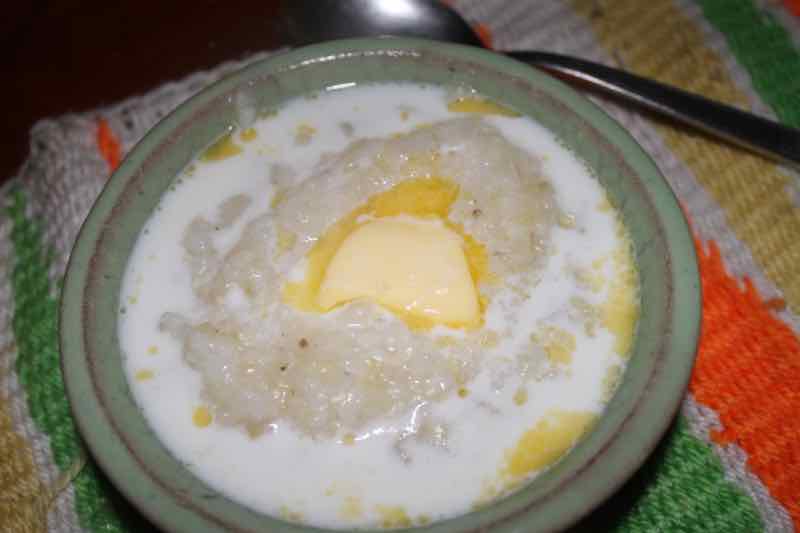 100% unrefined maize-meal porridge
100% unrefined maize-meal porridgeIngredients
1 cup of maizemeal weighing about 150 grams makes 4 generous helping of porridge; at a cost of about 20c each for those with a mill.
- 1 cup freshly ground 100% whole maize-meal
- 1 tsp salt
- Optional is a small stick or pinch of cinnamon
- 4 cups of boiling water
"Spiking food inflation is driving people in 2023 to spend 50% more on groceries than they did in 2019."
- SpendTrend23
Go for it
Depending on the mill you may get a small amount of the husk floating to the surface.
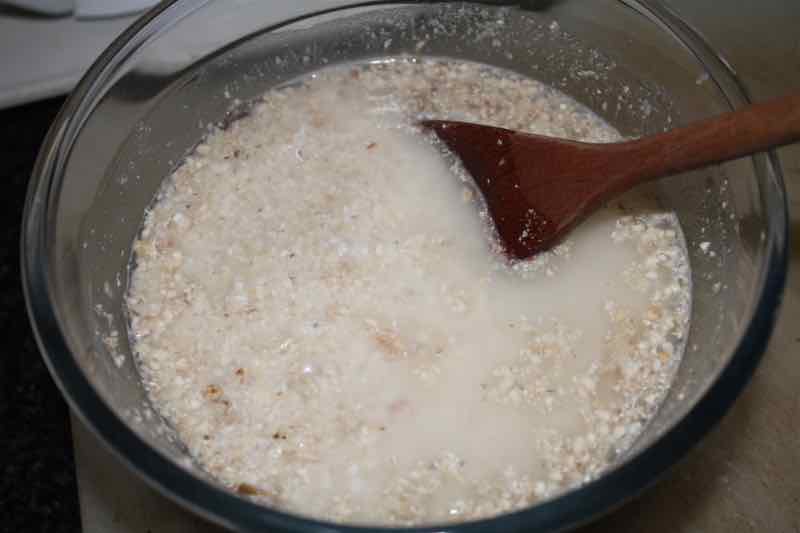 Make a paste of maize-meal and warm water.
Make a paste of maize-meal and warm water.- In the evening pour a cup of maize-meal and 1 teaspoon of salt into a large pot.
- Stir until it forms a thin paste.
- In the morning add three cups of boiling-water and turn to moderate heat.
- Stir continuously until it starts to boil and then turn the heat right down.
- Cook gently for about 40 minutes; stir occasionally.
- You can cook it immediately and then let the porridge gelatinise overnight either in a Wonderbox or on a slow wood stove; it takes time for the bran to hydrate. In the morning refrigerate half and bring the remainder back to the boil for ten minutes with a little boiling water.
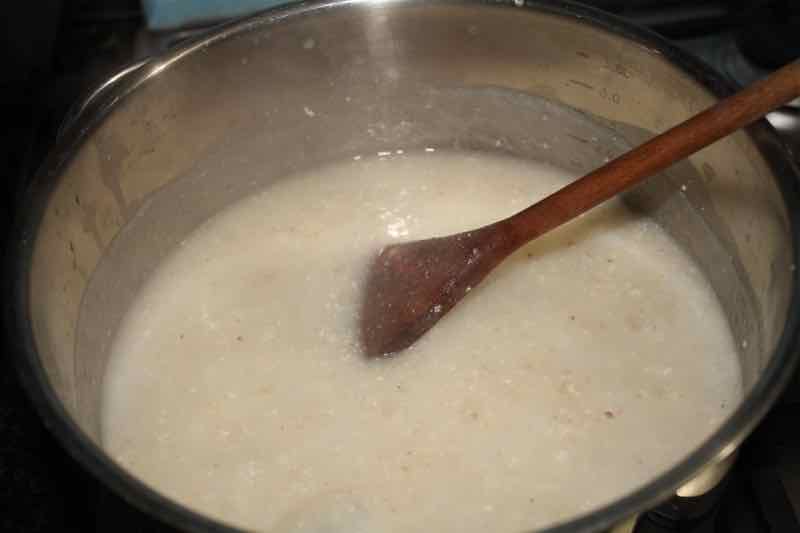 Add boiling water to the maize-meal paste.
Add boiling water to the maize-meal paste.In Europe this would be called polenta with differing degrees of refining; always check that it is true wholegrain.
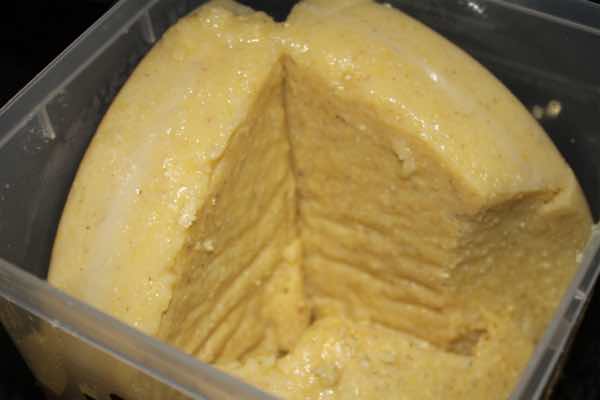 Cooled gelatinised maize-meal; corn grits.
Cooled gelatinised maize-meal; corn grits."Cooking by boiling yellow maize at 100 degrees C for 30 minutes increased the carotenoid concentration, while baking at 232o for 25 minutes diminished these important nutrient concentrations by almost 70%."
Enjoy
Maize-meal porridge is traditionally enjoyed with a lump of butter and milk; or maas, a thick fermented yoghurt made by the Zulu people. They are often lactose intolerant so dairy products must first be soured before eating. Alternatively today we recommend using kefir, a probiotic that has a much wider range of friendly bacteria, viruses and yeasts.
How to make kefir is very simple; it takes only five minutes.
There is no need for sweetening but one could add a teaspoon of natural-honey. Certainly do not use sugar; too much carb.
What's so special about wholegrain cornmeal?
Retrogradation
All starches particularly if they are made from refined meal, are glycemic; they are digested in the gut by the enzyme amylase, starting in the mouth. They break down into glucose molecules which are then absorbed in the small-bowel and carried by the portal blood stream to the liver.
Cooling a starch after it has been cooked allows the molecules to retrograde; they curl into a configuration that makes it more difficult for the amylase to do its work. Consequently the sugars are produced slowly and there is a smaller effect on blood-glucose; literally, it is less fattening.
Starches that have been cooled and allowed to retrograde are also thus less threatening to diabetics; they do not produce the surge in blood glucose of refined carbs.
"Many patients stop following standard-care diets such as daily calorie restriction because they become frustrated with having to monitor food intake vigilantly each day."
- Drs KA Varady and VM Oddo, University of Chicago
Consequently more of the starch passes through the small intestine undigested, reaching the colon where it acts as a prebiotic, providing nutrients for the teeming billions of bugs that turn it into very important short-chain fatty acids.
Maize-meal porridge, like many foods, also tastes better when allowed to cool and retrograde. For a greater understanding of this complex and important subject, read about the virtues of reheating resistant starch.
So currently this is our best way to cook wholegrain maizemeal porridge; prepare enough for several days and then allow it to cool and retrograde overnight. Then you can reheat it.
Hence we recommend that those who are insulin-resistant cook it the evening before for consumption the next day. Keep it overnight in that old cardboard Wonder Box; it has so many uses.
A small helping of wholegrain maize-meal porridge that has been retrograded would be allowed on one of these four distinct keto diets; keep down the glycemic load.
The fat in corn
Corn or maize as we call it in South Africa, has 2.1 grams of nutritious fat per cup (164g); not a lot. Roughly one-quarter is excellent monounsaturated lipid and a half is a poly.
About a tenth of that fat is saturated; there is zero-cholesterol.
Enjoyed in whole maize-meal porridge, or a fresh ear of corn it makes for a very nutritious breakfast; albeit deficient in some important amino acids, notably lysine.
Once extracted from the grain, because of the large proportion of polyunsaturated oils that fat becomes a highly inflammatory substance if used as a salad-dressing.
To keep the fatty acids in our food in balance we should make sure we are enjoying those that have a high monounsaturated content; notably from the olive, avocado and purslane.
In addition we want to keep the omega-3 fraction high; flaxseeds and cold water fish are the cheapest and simplest sources.
Traditionally
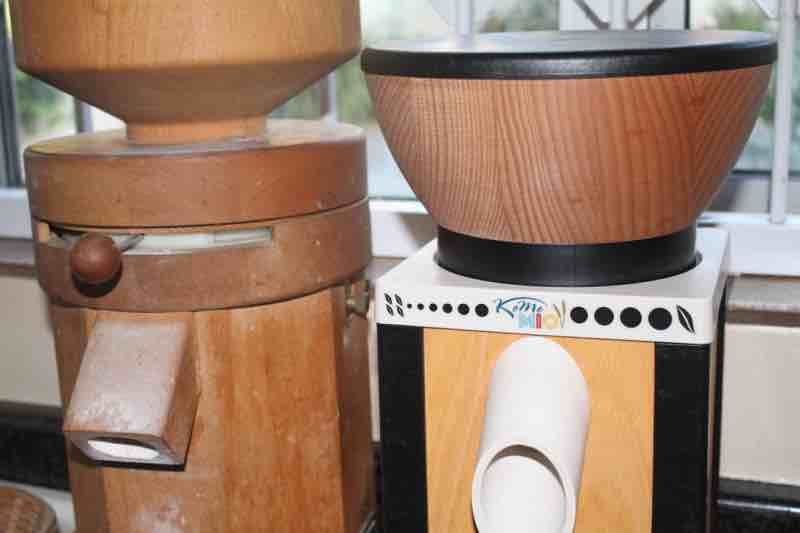
However once the kernel is split and oxygen gets in, the fats will start to go rancid. So traditionally farmers would grind their maize weekly and use it as soon as possible as a feed for themselves, their staff and animals.
Alas to their great detriment, most South Africans eschew the coarse whole grain in our maize-meal porridge, opting instead for the ultra refined option; it's made us one of the most obese nations in the world.
It's refined grains and sugar, not fat in the main that have made humans obese in the last few decades.
"Higher adolescent and early-adulthood intake of whole grains reduces the risk of breast cancer later in life by 26%[6]."

With 100% maize-meal now simply being unavailable, as with wheat, we have opted to buy a new grinder, the KoMo Mio[2] that will handle small quantities of corn.
And now in 2024 an industrial new-generation mill that produces super fine meal.
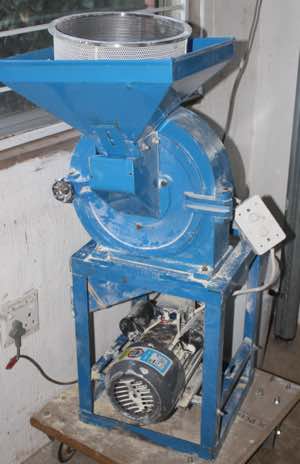 Isigayo, the maize mill.
Isigayo, the maize mill.Nutrients
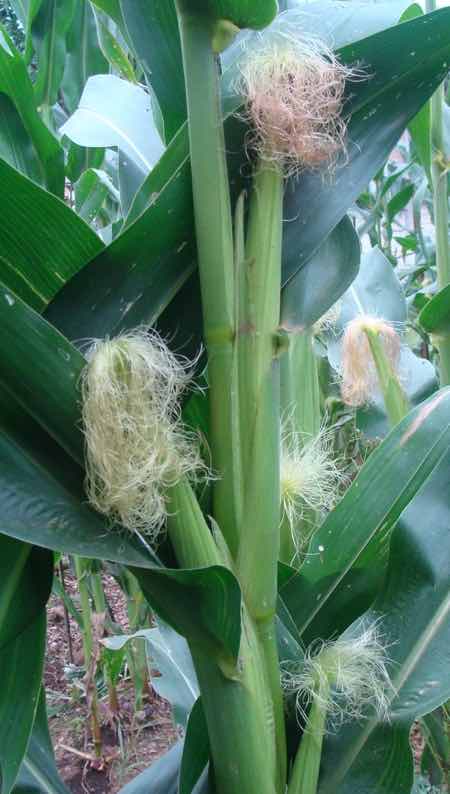
Unrefined yellow mealies are a good source of fibre, numerous B vitamins and many phytonutrients; especially beta-carotene, lutein and zeaxanthin that help prevent childhood and adult-onset blindness.
Food that is mostly refined carbohydrate and low in dietary fibre is regarded as being of high risk to wellness, limiting the production of those important short-chain fatty acids which protect the lining of the gut from toxic compounds.
Butyrate inhibits insulin production
One of these SCFAs called butyrate, not only supplies energy for the epithelial cells lining the colon but reduces oxidative stress and inflammation, precursors of neoplastic change. It also inhibits the insulin produced in response to the glucose from your maize-meal porridge carried via the portal vein to the liver; it is helpful for diabetics[1].
None of this is true of refined starches though; the loss of fibre contributes to constipation, a poorly-fed microbiome[3] and no butyrate.
Diabetics and in fact all of us should strictly limit refined starches from our food. This wholegrain maize-meal is quite different.
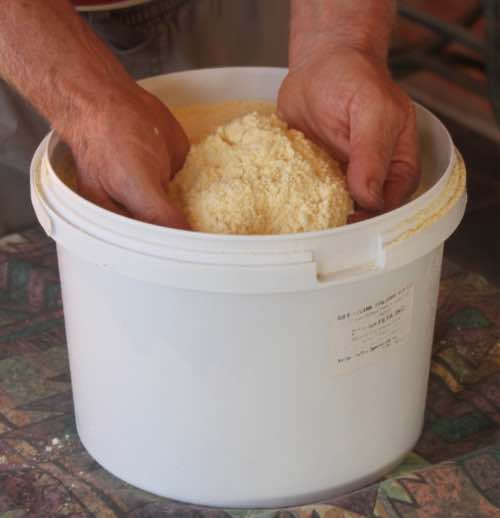 Super fine maizemeal
Super fine maizemealPublished data on various super refined maize-meals in South Africa is limited. So the following perhaps may not be strictly correct. The following points are noteworthy though.
- Most of the fat has been extracted from all varieties except Polenta.
- In particular the healthy monounsaturated fat content in comparison with 100% wholemeal is minimal.
- Significant protein in the germ and bran has been extracted in the refining process; nearly a half.
- The price rises dramatically after milling, by around four times for most brands; and over 10x for Polenta, the only one that comes even vaguely close to the whole grain in terms of nutrition.
- There is little data but some may have been "enriched" with synthetic vitamins and minerals to replace that which was extracted in the milling.
Why do we now choose yellow maizemeal?[7]
"The germ contains about 20% of the total protein in maize. At present it goes for animal feed but could be profitably used for human food because of its nutritional quality."
- Paolo Cerletti and Patrizia Restani, University of Milan
100g
Energy
Protein
Glyc carb
Total sugar
Total fat
Saturated
Mono
Poly
Price/kg
Vitamin A
B1
B2
B3
B6
Folate
Iron
Zinc
Calcium
Potassium
Magnesium
100%
1615
9.9
75
5.4
5.2
0.8
1.4
R4.10
1mcg
0.2mg
0.07mg
3.3mg
0.4mg
77mcg
1.9mg
3mg
15mg
0.9mcg
124mg
Polenta
1615
8.9
82
0.6
2.5
0.4
0.9
1.2
R54.95
Ace
1380
7.5
2g
1.7
0.2
R14.00
White star
1456
1g
1.6
0.4
R13.90
Woolies
7.6
80
0.7
0.8
0
0.1
2.1
15.60
123
0.5
0.3
3.8
0.3
5.2
2.5
Ferulic acid
Ferulic acid is a much-prized polyphenol used in extremely expensive skin care products. It is an antioxidant located solely in the bran; maize has the largest amount of all the grains.
Ferulic acid reduces inflammation, signs of aging and evens out the skin's tone. As an antioxidant it mops up destructive free radicals produced during normal cell respiration.
Maize-meal porridge is an excellent source of this important phenolic compound. It is completely lost in the refining process.
About 12% of maize bran consists of particularly high quality amino-acids[5]; about 1.5 percent of the total protein in the kernel.
So the bran and germ contain nearly a quarter of the protein in the whole grain; and nearly 50% in unprocessed yellow maize-meal.
Obesity
"Abundant fiber content in whole grains could significantly control insulin resistance, decreasing body adiposity and contributing to reducing risks of cancer[6]."
Whilst whole grains have enormous benefits for us and are not fattening, if you actually need to lose weight you have to get your daily carbohydrate intake below 50g. Thus I would recommend only very small helpings of maize-meal porridge, even this special polenta grits for the obese.
A small stick of cinnamon helps with glycemic control.
Take perhaps only 3 tablespoons to keep the glycemic-load down; 1.6g of carbs per TBSP.
Why whole-grain is better is a question everyone should be able to answer.
“Health remains a fundamental building block of the humane society we are determined to create through the implementation of the Reconstruction and Development Programme.”
- Nelson Mandela
South Africa will never be a humane and healthy society as long as millers are allowed to dominate the market with super-refined number one maize meal; much of the protein, vitamins and phytonutrients, the best parts have been extracted and sold off as pig food.
It should attract a sin-tax; same as sugar, alcohol and tobacco.
We continue to espouse the view confirmed many times by strong science that diets simply don't work; and people find them very frustrating. After one year only 5% have actually lost weight and many have put on; because they are not sustainable.
Far simpler is to return to the meals our great-grandparents ate; whole grains, plenty of fruit and vegetables. Some meat, not excessive dairy products and unlimited legumes provide the protein; shun the ultra processed foods that cover 75% of grocery store shelves.
Succotash would typify those meals; corn and beans.
"There is little support for the notion that diets lead to lasting weight-loss or health benefits.
We concluded most would have been better off not going on them at all."
- Prof Traci Mann, U of Minn, Health and Eating lab[1]
Weight loss medication
Those who enjoy mainly whole grains like this maize meal porridge will never be faced with the awful dilemma of whether to start weight loss medication or not; whatever changes you make have to be for life.
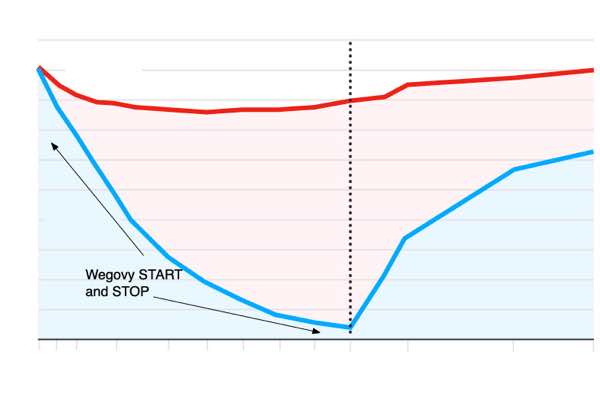 What happens when you stop the medication
What happens when you stop the medicationIf you return to refined grains or stop taking the medication, all was in vain; the adipose just returns. Whether we live healthy long lives or suffer from the ravages of obesity is determined by our choices.
Maize-meal porridge
Maize-meal porridge is only worth making with freshly ground whole corn; if you can get it. Add some berries for extra benefit.
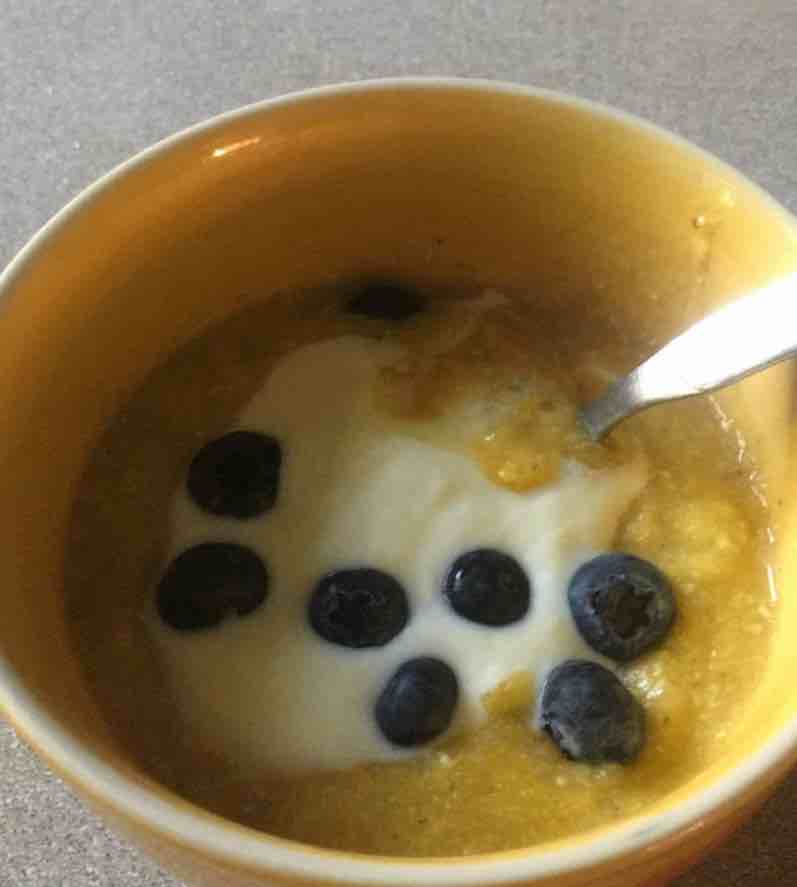
Humans are expected to eat ultra-refined white cornmeal; there is little nutritional information on it. One option is to enrich your grits with greens and other vegetables.
Our green journey has meant a life of experimentation and fun with different foodstuffs; and where possible, trying to grow as much of our own as we are able. Having discovered the vast benefits of 100% wholemeal from wheat, we are now doing the same with corn. An industrial mill has just been delivered and the mealies sourced.
But there is another issue at play; this is our first real attempt to find out for ourselves some answers on genetically modified foods. This yellow maize seed non-GM.
We have since 2022 sourced non-GM yellow maize; it's certainly more nutritious than the white and has greater flavour. The chickens also prefer it. The seeds planted in our green garden are yielding exceptional corn on the cob.
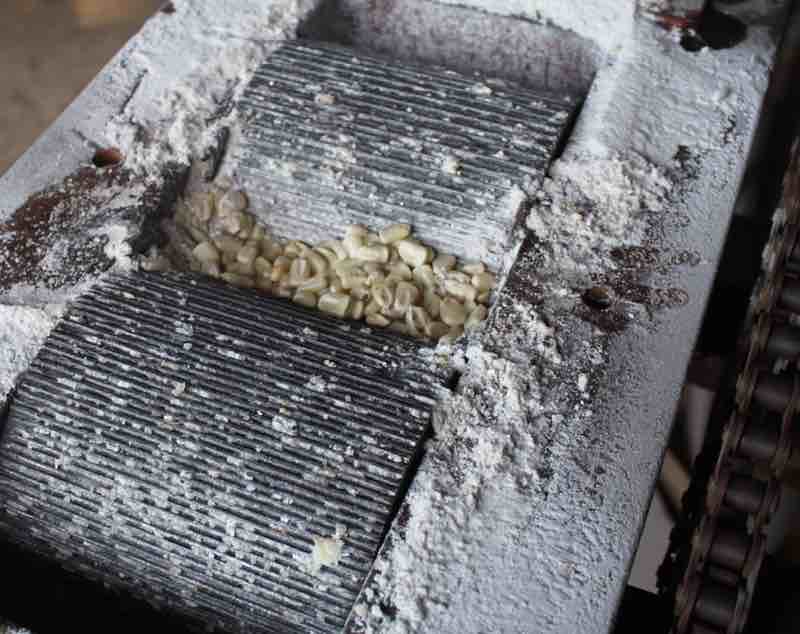 An old-fashioned roller mill cannot produce fine meal
An old-fashioned roller mill cannot produce fine mealThe mill below however produces extra-fine maizemeal with no separation of the three streams.
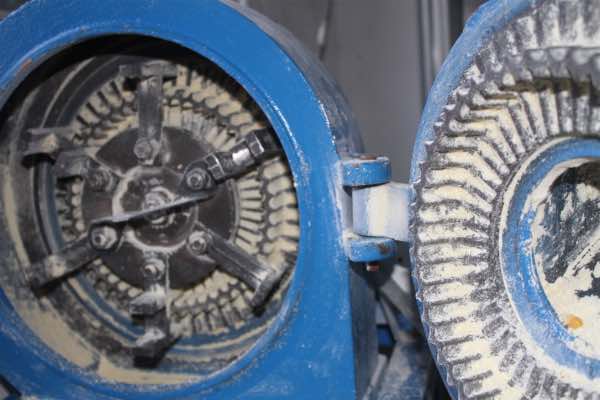
"In the milling the pericarp and germ of maize are usually sieved out as chaff in the preparation of most traditional foods. That leads to loss of a large portion of the proteins, lipids and minerals that are present in those kernel structures; and vitamins too."
- Food Reviews International 35(4), April 2019
Nixtamalization
Maize in Mexico and some parts of Africa is cooked with either lime or wood ash. There are numerous nutritional benefits[4].
- Increased availability of niacin; reduced risk of pellagra.
- Increased calcium availability.
- Increased resistant starch.
- Reduced mycotoxin contamination due to removal of the pericarp.
- Lower levels of phytic acid that inhibits iron and zinc absorption.
This is an area of interest for the future.
Semolina, grits and polenta
These terms are used interchangeably and confusingly.
Semolina is coarser, has a slightly sweeter flavour and a nutty aroma.
Polenta is ground finer and is often partially refined; sometimes using a stone mill. It is usually cooked with water or a vegetable stock; and made into porridge. It may be sweetened with raw honey, apple compote or plum jam; or fresh fruit.
American grits is apparently ground in a different way.
Bramata is cooked with herbs like rosemary or thyme.
Is cornmeal the same as grits?
Yes cornmeal is the same as grits but they are milled in many different ways; producing varying grades of fineness.
As a general rule, the coarser the less likely it is to be refined.
But we have purchased a newly designed mill that yields very fine maize-meal; with no separation of the three streams.
The only way to know whether your cornmeal is wholegrain is to contact the miller; the packaging is unlikely to declare "nothing but the truth."
Usefulness
I hope you have found this page about maize-meal porridge useful in your search for better health. Certainly the commonly used super refined grits eaten today does not supply the nutrients and energy that define a good food.
- Microbial Degradation of Whole-Grain Complex Carbohydrates and Impact on Short-Chain Fatty Acids
- Komo Mio mill
- Re-establish the intestinal microbes
- Sub-Saharan African Maize-Based Foods- Processing Practices
- Corn Bran
- Whole Grain Consumption for the Prevention and Treatment of Breast Cancer
- Why do we choose yellow maizemeal?
When browsing use right click and Open Link in New Tab, or you may get a bad gateway signal.
What is maize meal good for?
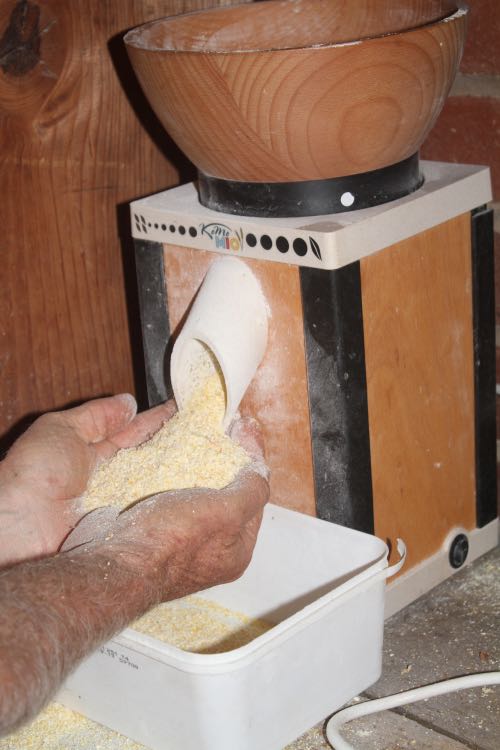 A small stone mill
A small stone millRefined maize meal is good for nothing. It's a junk food that makes us fat, diabetic and knocks years off our lives; and is one of the chief causes of stunting of South African children.
Ironically unrefined maize meal is one of God's great gifts to the planet. First appreciated by the Incas in Central America it is an amazing source of energy, important nutrients and wonderful flavour; but it is increasingly difficult to source. It certainly has a shelf life, so millers extract the fat.
You may have to purchase your own mill if you are serious about the benefits of maize-meal porridge.
SUMMARY
- Unrefined maize-meal porridge is a true wholegrain.
- It is a rich source of fibre, important minerals and vitamins; and phytonutrients.
- It has a low glycemic index but it is still "starchy." The glucose is released more slowly if it is allowed to retrograde overnight.
Newsletter
Our newsletter is entitled "create a cyan zone" at your home, preserving both yourself and Mother Earth for future generations; and the family too, of course. We promise not to spam you with daily emails promoting various products. You may get an occasional nudge to buy one of my books.
Here are the back issues.
- Lifestyle and ideal body weight
- What are ultra-processed foods?
- Investing in long-term health
- Diseases from plastic exposure
- Intensive lifestyle management for obesity has limited value
- A world largely devoid of Parkinson's Disease
- The impact of friendly bacteria in the tum on the prevention of cancer
- There's a hole in the bucket
- Everyone is talking about weight loss drugs
- Pull the sweet tooth
- If you suffer from heartburn plant a susu
- Refined maize meal and stunting
- Should agriculture and industry get priority for water and electricity?
- Nature is calling
- Mill your own flour
- Bake your own sourdough bread
- Microplastics from our water
- Alternative types of water storage
- Wear your clothes out
- Comfort foods
- Create a bee-friendly environment
- Go to bed slightly hungry
- Keep bees
- Blue zone folk are religious
- Reduce plastic waste
- Family is important
- What can go in compost?
- Grow broad beans for longevity
- Harvest and store sunshine
- Blue zone exercise
- Harvest and store your rainwater
- Create a cyan zone at your home
Did you find this page interesting? How about forwarding it to a friendly book or food junkie? Better still, a social media tick would help.
- Bernard Preston homepage
- Breakfast
- Maize-meal Porridge
Address:
56 Groenekloof Rd,
Hilton, KZN
South Africa
Website:
https://www.bernard-preston.com